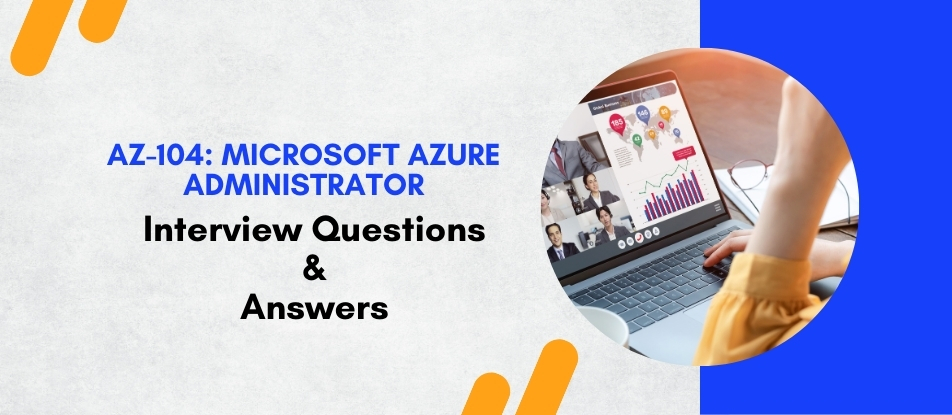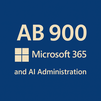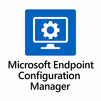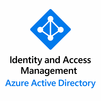
The Microsoft Azure Administrator training equips participants with the skills needed to implement, monitor, and maintain Microsoft Azure solutions, including major services related to compute, storage, network, and security. This course provides practical knowledge through hands-on labs and simulations, preparing learners to manage Azure subscriptions, secure identities, administer the infrastructure, and understand Azure's integrated cloud resources effectively.
AZ-104: Microsoft Azure Administrator Interview Questions Answers - For Intermediate
1. What is Azure Cosmos DB?
Azure Cosmos DB is a globally distributed, multi-model database service provided by Microsoft Azure. It is designed to elastically and independently scale throughput and storage across any number of Azure regions worldwide.
2. What is Azure Virtual Network Gateway?
Azure Virtual Network Gateway is a network gateway service that enables you to create cross-premises connectivity between your on-premises network and Azure Virtual Network. It supports VPN and ExpressRoute connections.
3. What is Azure ExpressRoute?
Azure ExpressRoute is a dedicated private connection between an organization's on-premises network and Azure datacenters. It provides higher security, reliability, and faster speeds compared to typical internet connections.
4. What is Azure CDN (Content Delivery Network)?
Azure CDN is a distributed network of servers that delivers web content, such as images, videos, and static files, to users based on their geographic location. It improves the performance and availability of web applications by caching content closer to end-users.
5. What is Azure Logic Apps?
Azure Logic Apps is a cloud-based service that allows you to automate workflows and integrate apps, data, systems, and services across enterprises or organizations.
6. What is Azure Firewall?
Azure Firewall is a managed, cloud-based network security service that protects your Azure Virtual Network resources. It provides stateful firewall capabilities with built-in high availability and scalability.
7. What is Azure Active Directory Domain Services (Azure AD DS)?
Azure Active Directory Domain Services is a managed domain service provided by Azure that integrates with Azure AD. It allows you to join Azure Virtual Machines to a domain without the need for domain controllers.
8. What is Azure Storage Blob Access Tiers?
Azure Storage Blob Access Tiers allow you to store blobs at different levels of access and pricing. The tiers include hot, cool, and archive, each optimized for different access patterns and costs.
9. What is Azure Load Balancer Standard SKU?
Azure Load Balancer Standard SKU is a higher-tier offering of Azure Load Balancer that provides additional features such as multiple frontends, HA ports, and outbound connections.
10. What is Azure Front Door?
Azure Front Door is a scalable and secure entry point for fast delivery of global web applications. It provides intelligent routing, SSL offloading, and application acceleration capabilities.
11. What is Azure Functions Premium Plan?
Azure Functions Premium Plan is a higher-tier offering of Azure Functions that provides enhanced performance, scale, and features such as VNET integration, Durable Functions, and longer execution duration.
12. What is Azure SQL Managed Instance?
Azure SQL Managed Instance is a fully managed SQL Server instance hosted in Azure. It offers near 100% compatibility with SQL Server, built-in high availability, and automatic backups.
13. What is Azure Security Center?
Azure Security Center is a unified security management system that provides advanced threat protection across hybrid cloud workloads. It helps you to prevent, detect, and respond to security threats.
14. What is Azure Kubernetes Service (AKS)?
Azure Kubernetes Service is a managed Kubernetes container orchestration service provided by Azure. It simplifies the deployment, management, and scaling of containerized applications using Kubernetes.
15. What is Azure Bastion?
Azure Bastion is a fully managed PaaS service that provides secure and seamless RDP and SSH access to virtual machines directly through the Azure Portal. It eliminates the need for public IP addresses or VPN connections.
16. What is Azure Cost Management + Billing?
Azure Cost Management + Billing is a service that helps you to monitor, analyze, and optimize your Azure spending. It provides cost tracking, budgeting, and forecasting capabilities.
17. What is Azure Service Health?
Azure Service Health is a personalized dashboard that provides information on the health and availability of Azure services in the regions where you have resources deployed. It alerts you to service issues and planned maintenance events.
18. What is Azure Resource Graph?
Azure Resource Graph is a service that allows you to query and explore your Azure resources at scale using a powerful query language. It provides a unified view of your resource inventory across subscriptions and regions.
19. What is Azure Private Link?
Azure Private Link is a service that enables private connectivity between Azure Virtual Network resources and Azure PaaS services, Microsoft services, or your own services hosted in Azure.
20. What is Azure Policy?
Azure Policy is a service that helps you to enforce organizational standards and compliance controls across your Azure environment. It allows you to create, assign, and manage policies to ensure resources adhere to corporate standards and regulations.
AZ-104: Microsoft Azure Administrator Interview Questions Answers - For Advanced
1. What steps would you take to secure a large number of Azure virtual machines?
To secure a large number of Azure virtual machines, one would start by implementing Azure Security Center for an integrated security monitoring and policy management across Azure subscriptions. It’s crucial to activate adaptive application controls to create whitelisting rules for applications, utilize just-in-time VM access to reduce exposure to attacks, and implement network security groups and Azure Firewall to control inbound and outbound traffic. Additionally, managing access using Azure Active Directory and role-based access control (RBAC) ensures that only authorized personnel can perform specific actions.
2. How do you manage cost optimization in Azure?
Cost optimization in Azure can be managed by assessing and right-sizing virtual machine scales to fit performance needs while minimizing costs. Utilizing reserved instances and Azure Hybrid Benefits can significantly reduce costs for consistent workloads. Implementing Azure Cost Management tools helps in monitoring, allocating, and optimizing resources effectively. Turning off unused resources and automating start-stop schedules can also reduce costs significantly.
3. Explain how you would design a disaster recovery strategy for Azure.
A disaster recovery strategy for Azure involves first assessing the business impact and defining recovery objectives. Azure Site Recovery should be utilized to automate the replication of virtual machines to a secondary region. Regularly scheduled drills should be performed to ensure that the failover mechanisms are effective. Azure Backup service is essential for protecting and restoring data at the application level. The strategy should also include a clear communication plan during and after a disaster recovery event.
4. Can you describe the steps to implement an Azure Virtual Network and configure its connectivity with an on-premises data center?
To implement an Azure Virtual Network, one needs to define the subnet design and create the virtual network with specific address ranges. Next, to configure connectivity with an on-premises data center, setting up a Site-to-Site VPN or Azure ExpressRoute is necessary for a more stable and secure connection. This involves configuring VPN gateways on both the Azure and on-premises sides and ensuring that routing tables and security policies allow for the intended traffic flows.
5. Discuss the process and benefits of using Azure Automation.
Azure Automation provides a way to automate frequent, time-consuming, and error-prone cloud management tasks. The process involves creating automation runbooks in PowerShell or Python that help manage resources across multiple Azure and non-Azure environments. This automation helps improve operational efficiency, reduces the potential for human error, and allows for scaling operations more effectively. It’s also beneficial for deploying updates, managing configurations, and monitoring Azure resources.
6. What are Azure Policies and how would you use them?
Azure Policies are rules that govern resource properties during deployment and throughout their lifecycle. They are used to enforce organizational standards and to assess compliance at scale. Typical use cases include enforcing specific configurations, such as ensuring that only allowed VM sizes are deployed or that resources are tagged correctly. Policies can be applied at different scopes, from a management group to individual resources, providing flexibility in governance and compliance monitoring.
7. Explain the role of Azure Active Directory in managing identities.
Azure Active Directory (Azure AD) is a cloud-based identity and access management service that helps employees sign in and access resources in Azure, as well as external resources like Microsoft Office 365 and hundreds of other SaaS applications. Azure AD is used to manage user identities and create policy-based access control. Features such as Multi-Factor Authentication and conditional access provide enhanced security layers that help protect against unauthorized access to critical resources.
8. How would you migrate an application and its data to Azure?
Migrating an application and its data to Azure involves several key steps: Firstly, assess the on-premises application's architecture and dependencies using tools like Azure Migrate to understand the scope and requirements of the migration. Plan the migration strategy—rehost, refactor, rearchitect, or rebuild. Use Azure Site Recovery for rehosting VMs or Azure Database Migration Service for moving databases. Finally, once migrated, optimize the application for cloud scalability and cost efficiency.
9. Describe how you would use Azure Monitor and Azure Alerts.
Azure Monitor and Azure Alerts are crucial for maintaining the health and performance of applications and services. Azure Monitor collects and analyzes performance metrics and log data from cloud and on-premises environments, providing insights through dashboards and visualizations. Azure Alerts are then set up based on these metrics or logs to notify administrators about critical conditions that could impact availability or performance. This enables proactive intervention to maintain service levels and operational health.
10. What is Azure ExpressRoute and what are its benefits?
Azure ExpressRoute is a service that provides a private, dedicated, high-throughput network connection between Azure data centers and on-premises infrastructure. Its benefits include more reliable and predictable performance, lower latency, and enhanced security compared to typical internet connections. ExpressRoute is particularly beneficial for transferring large volumes of data, such as during data migration projects or when running high-performance computing applications, because it bypasses the public internet.
Course Schedule
| Dec, 2025 | Weekdays | Mon-Fri | Enquire Now |
| Weekend | Sat-Sun | Enquire Now | |
| Jan, 2026 | Weekdays | Mon-Fri | Enquire Now |
| Weekend | Sat-Sun | Enquire Now |
Related Courses
Related Articles
Related Interview
Related FAQ's
- Instructor-led Live Online Interactive Training
- Project Based Customized Learning
- Fast Track Training Program
- Self-paced learning
- In one-on-one training, you have the flexibility to choose the days, timings, and duration according to your preferences.
- We create a personalized training calendar based on your chosen schedule.
- Complete Live Online Interactive Training of the Course
- After Training Recorded Videos
- Session-wise Learning Material and notes for lifetime
- Practical & Assignments exercises
- Global Course Completion Certificate
- 24x7 after Training Support











 Join our Live Instructor-Led online classes delivered by industry experts
Join our Live Instructor-Led online classes delivered by industry experts